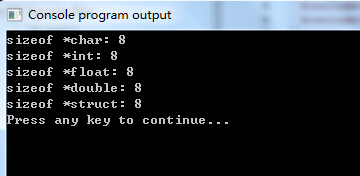本文地址:http://www.cnblogs.com/archimedes/p/point-length-type.html,轉載請注明源地址。
如果考慮應用程序的兼容性和可移植性,指針的長度就是一個問題,在大部分現代平台上,數據指針的長度通常是一樣的,與指針類型無關,盡管C標准沒有規定所有類型指針的長度相同,但是通常實際情況就是這樣。但是函數指針長度可能與數據指針的長度不同。
指針的長度取決於使用的機器和編譯器,例如:在現代windows上,指針是32位或是64位長
測試代碼:
#include<stdio.h>
#include<math.h>
#include<stdlib.h>
#include<stddef.h>
struct p{
int n;
float f;
};
int main()
{
struct p *sptr;
printf("sizeof *char: %d\n", sizeof(char*));
printf("sizeof *int: %d\n", sizeof(int*));
printf("sizeof *float: %d\n", sizeof(float*));
printf("sizeof *double: %d\n", sizeof(double*));
printf("sizeof *struct: %d\n", sizeof(sptr));
return 0;
}
運行結果:

指針相關的預定義類型:
size_t 類型是標准C庫中定義的,應為unsigned int,在64位系統中為 long unsigned int。 C語言中,此類型位於頭文件stddef.h中。它是一個與機器相關的unsigned類型,其大小足以保證存儲內存中對象的大小,它的目的是提供一種可移植的方法來聲明與系統中可尋址的內存區域一致的長度:
因為C/C++標准只定義一最低的位數,而不是必需的固定位數。而且在內存裡,對數的高位對齊存儲還是低位對齊存儲各系統都不一樣。為了提高代碼的可移植性,就有必要定義這樣的數據類型。一般這種類型都會定義到它具體占幾位內存等。當然,有些是編譯器或系統已經給定義好的。經測試發現,在32位系統中size_t是4字節的,而在64位系統中,size_t是8字節的,這樣利用該類型可以增強程序的可移植性。
size_t類型用作sizeof操作符的返回類型,同時也是很多函數的參數類型,包括malloc和strlen
在聲明例如字符數、或者數組索引這樣的長度變量時用size_t是好的做法,它經常用於循環計數器、數組索引,有時候還用在指針算術運算上
打印size_t類型的值要小心,這是無符號值,如果選錯格式說明符,可能會得到不可靠的結果,推薦的格式說明符是%zu,在某些情況下可以考慮用%u或%lu替代
#include<stdio.h>
#include<stddef.h>
#include<string.h>
int main(void)
{
char str[] = "Hello world!";
char *pstart = str;
char *pend = str + strlen(str);
ptrdiff_t difp = pend - pstart;
printf("%d\n", difp);
return 0;
}
intptr_t與uintptr_t類型用來存放指針地址,它們提供了一種可移植且安全的方法聲明指針,而且與系統中使用的指針的長度相同,對於把指針轉化為整數形式很有用。uintptr_t是intptr_t的無符號版本
關於intptr_t的類型定義如下:
/* Types for `void *' pointers. */ #if __WORDSIZE == 64 # ifndef __intptr_t_defined typedef long int intptr_t; # define __intptr_t_defined # endif typedef unsigned long int uintptr_t; #else # ifndef __intptr_t_defined typedef int intptr_t; # define __intptr_t_defined # endif typedef unsigned int uintptr_t; #endif
從定義可以看出,intptr_t在不同的平台是不一樣的,始終與地址位數相同,因此用來存放地址。
概念上, 盡管地址是指針, 內存管理常常使用一個無符號的整數類型更好地完成; 內核對待物理內存如同一個大數組, 並且內存地址只是一個數組索引. 進一步地, 一個指針容易解引用; 當直接處理內存存取時, 你幾乎從不想以這種方式解引用. 使用一個整數類型避免了這種解引用, 因此避免了 bug. 因此, 內核中通常的內存地址常常是 unsigned long, 利用了指針和長整型一直是相同大小的這個事實, 至少在 Linux 目前支持的所有平台上.C99 標准定義了 intptr_t 和 uintptr_t 類型給一個可以持有一個指針值的整型變量
測試代碼:
#include <stdio.h>
#include <stdlib.h>
#include <unistd.h>
#include <stdint.h>
#include <string.h>
#include <assert.h>
#define ID_STR_LEN 12
#define NAME_STR_LEN 10
typedef struct student
{
char id[ID_STR_LEN];
char name[NAME_STR_LEN];
uint8_t age;
}student;
student * create_student()
{
student *stu = (student *)malloc(sizeof(student));
if (stu == NULL)
return NULL;
memset(stu, 0, sizeof(student));
return stu;
}
void *free_student(student *stu)
{
if (stu)
free(stu);
return 0;
}
static void init_student(student * stu)
{
assert(stu);
const char *id = "2013112210";
const char *name = "Anker";
uint8_t age = 21;
memcpy(stu->id, id, strlen(id));
memcpy(stu->name, name, strlen(name));
stu->age = age;
}
static int handle_student(intptr_t handle)
{
if (handle == 0)
{
return -1;
}
student *stu = (student*)handle;
printf("id: %s\n", stu->id);
printf("name: %s\n", stu->name);
printf("age: %u\n", stu->age);
return 0;
}
int main(void)
{
student *stu;
stu = create_student();
init_student(stu);
//將指針轉換為intptr_t類型
intptr_t handle = (intptr_t)stu;
handle_student(handle);
free_student(stu);
return 0;
}
參考資料:
http://www.cnblogs.com/Anker/p/3438480.html